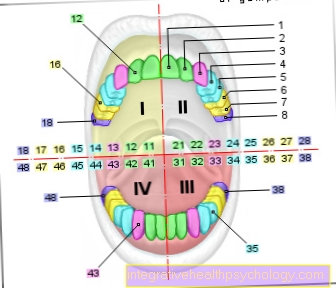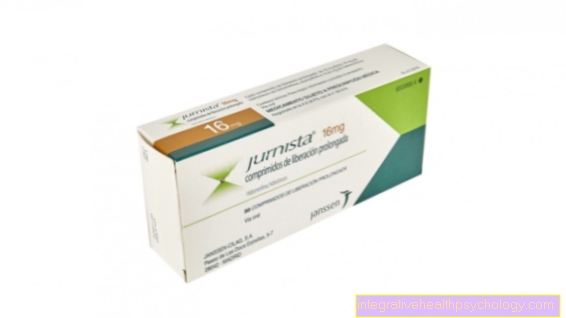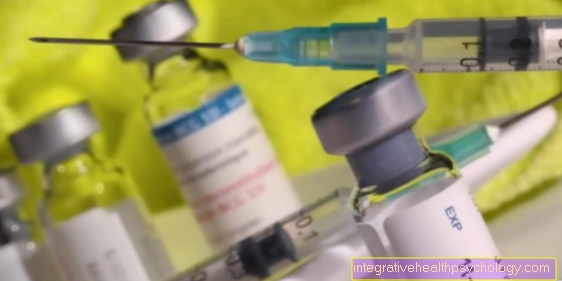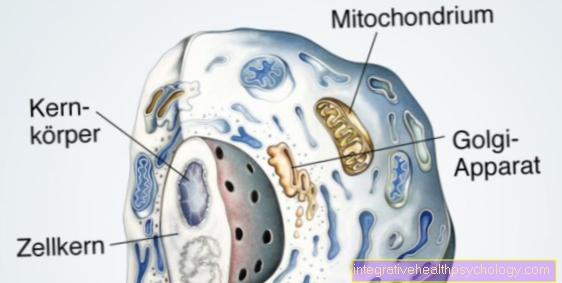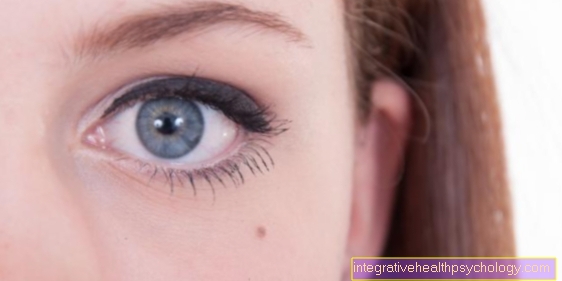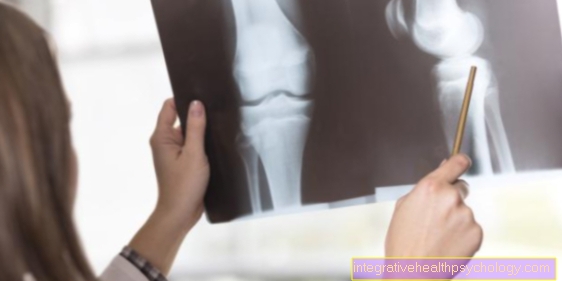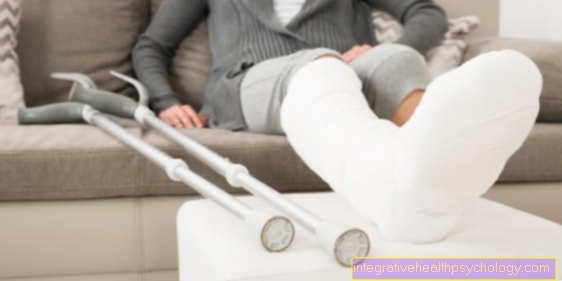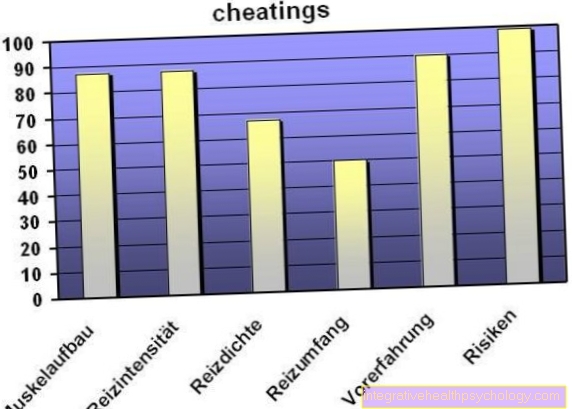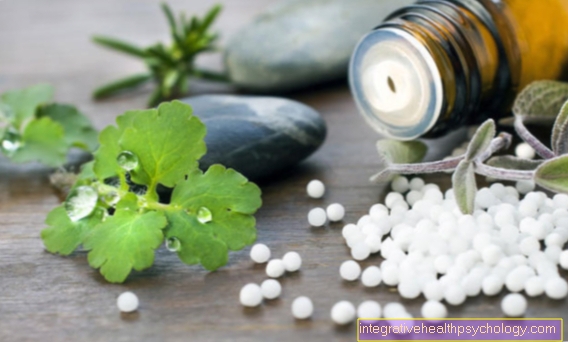Chronic venous insufficiency - you need to know that!
Chronic venous insufficiency arises from weak veins. In the process, more and more blood builds up in the leg veins, for example due to incorrectly closing venous valves. These expand as a result. If this build-up of the blood persists, fluid can escape from the vessels. This creates water retention in the legs. In addition, chronic venous insufficiency leads to changes in the skin that can even lead to ulcers.

Causes of chronic venous insufficiency
The chronic venous insufficiency arises from a weak vein, the cause of which is usually a loss of function of the venous valves. When the heart beats, blood circulates to and from all parts of the body. So the blood from the legs has to be pumped up again. So that the blood does not flow down again due to gravity after the heartbeat, there are venous valves that close and thus prevent backflow. However, in some circumstances they do not close properly.
Causes for it can
- Overweight,
- a weak connective tissue,
- more familial disposition,
- the female gender,
- a pregnancy,
- a lack of exercise or
- a job that often involves standing or sitting for a long time.
The backflow of blood into the leg veins leads to a build-up of blood. As a result, the pressure in the vessels increases and the veins expand. As a result, for example, water escapes from the vessels and collects in the tissue. Varicose veins can also develop. If this condition persists for a long time, the veins suffer more and more damage and one speaks of chronic venous insufficiency.
Learn how to Remove varicose veins can.
Apart from a disease of the venous valves, blood congestion can also result from an obstruction to drainage, such as a thrombosis.
Read about that Causes of Thrombosis.
How is the diagnosis made?
For the diagnosis of chronic venous insufficiency, the functionality of the veins and the venous valves play an important role. First, the veins on the legs can be viewed and felt in a physical examination. Typically, varicose veins are clearly visible and palpable.
The diagnosis of chronic venous insufficiency is made with the help of an ultrasound examination. The blood build-up and blood flow in the leg veins can be observed. This shows whether enough blood is being transported and how much blood is flowing back into the legs. This investigation is called Duplex sonography.
The diagnostics are followed by special function tests that test the filling of the leg veins under stress and against gravity.
Another method to visualize the leg veins is an X-ray examination with contrast agent. she will Venography called and, in contrast to ultrasound, involves a certain amount of radiation exposure. The Venography should still be performed if a thrombosis is suspected, as this is the most appropriate procedure in this case.
Get general information about the Diagnosis of thrombosis.
What stages are there?
The chronic venous insufficiency is after Widmer divided into three stages. The classification is based on the patient's symptoms.
In the first stage, reversible water retention occurs. This means the accumulations of water, which show up in the form of swelling in the legs, are differently pronounced, for example, depending on the ambient temperature and the time of day, and sometimes disappear completely. In addition, in the first stage, some dark blue veins are visible on the side of the foot.
In the second stage, the water retention in the legs persists and the subcutaneous fatty tissue hardens. Furthermore, veins can become inflamed from the irritation. As a result, the leg continues to swell, becomes red and warm. The skin can feel dry and tight. In addition, small veins can become inflamed and cause scars on the surface of the skin. These then appear as white areas, for example on the back of the foot. There are also yellowish to brown areas on the skin, which are probably caused by deposits of blood breakdown products.
In the third and most serious stage, the damage to the legs is so pronounced that ulcers occur, especially on the lower legs (ulcus cruris). This can lead to a so-called open leg.
Find out about the therapy and prognosis of the open leg.
Concomitant symptoms of chronic venous insufficiency
The amount of blood that has built up in the leg veins also flows into the smaller side branches of the veins, which also expand. This is how so-called spider veins develop. In them you can see the sunk blood in the small vessels and they shine like thin cobwebs through the skin. The accumulated blood in the slightly larger veins forms protruding varicose veins.
If the chronic venous insufficiency progresses further, some accompanying symptoms occur. These occur when the blood collects in the leg veins. As a result, the legs become fat, heavy, and tire more easily. Unpleasant sensations such as a feeling of tension, itching or pain in the form of calf cramps occur.
Read what other possible causes of one Burning in the leg could be.
The tension in the veins also causes fluid to leak from the vessels and accumulate in the tissues of the lower leg. These pools of water are mostly found on the ankles.
On warm days, the veins expand even further and more blood can collect in them. This can also make symptoms and pain worse. If the person concerned is standing or sitting, the blood will flow back to the heart worse than when lying down. The symptoms therefore usually worsen over the course of the day and have reached their maximum pain level in the evening.
In contrast, the pain improves quickly when the legs are raised.
Find out what other diseases Cause pain in the calf can.
Edema
Water retention in the tissue is called edema. With chronic venous insufficiency, large amounts of blood accumulate in the leg veins. This creates a very high pressure in the vessels and they expand. However, if the blood congestion worsens, the pressure continues to rise. This causes fluid to escape from the veins and collect in the surrounding tissue.
This water retention occurs first on the ankles as the fluid is pulled down by gravity. In the course of the disease, the edema can appear all over the lower leg.
Depending on the stage of chronic venous insufficiency, the edema varies in severity and occurs repeatedly or permanently.
Find out what you're up against Edema in the legs can undertake.
What can be the long-term consequences?
As a complication of chronic venous insufficiency, for example, bleeding from the varicose veins can occur. This can be caused by the increased tension due to the build-up of blood or an injury or an accident. Veins with a thin wall that lie just below the skin are often affected. It then bleeds openly out of the varicose vein or under the skin. In the event of such bleeding, the affected area should be tied off and placed high up.
Inflammation of the affected veins is another complication. The expansion of the veins caused by the congestion of blood leads to irritation that can lead to inflammation. This manifests itself in the form of pain, redness and further swelling of the legs.
Furthermore, deep vein thrombosis can be a long-term consequence of chronic venous insufficiency.
Since the veins of the legs are dilated, small tears in the vessel wall can occur. Platelets can attach to these spots. In addition, the blood can clot due to the build-up and settle there. This leads to a narrowing of the vascular opening known as thrombosis. It is particularly dangerous because the blood clot can separate from the wall and carry it to the lungs, where it leads to pulmonary embolism.
Another very important complication is that Leg Ulcer.
Leg Ulcer
The Leg Ulcer is an ulcer on the lower leg caused by chronic venous insufficiency. The upper layers of the skin are no longer properly supplied with blood, for example due to the swelling of the leg. The cells of the immune system can no longer get there and even the smallest injuries can no longer heal, which leads to an ulcer.
The ulcer usually occurs a little above the inner ankle, usually does not hurt and often oozes. The affected area should continue to be moved to encourage blood flow. The wound should also be treated externally to promote healing. However, even after healing, the affected area should be monitored and the underlying disease treated, as ulcers often recur in the same area.
Learn more about the therapy of the Leg Ulcer.
Therapy of chronic venous insufficiency
The therapy depends on the stage of the disease and the severity of the symptoms. The first goal is to improve the flow of blood from the leg veins. The diseased sections of the vascular system should be as functional as possible, so that the blood does not back up in other parts of the body and cause permanent damage there.
Initially, a purely conservative therapy with compression stockings or bandages is sought. The compression stockings can be selected in different thicknesses depending on the severity of the venous insufficiency. Applying cold from the bottom up can also lead to improved blood flow due to the strong contraction of the veins in the cold. Standing for long periods should be avoided, as heat (for example in the sauna) is harmful. On the other hand, lots of exercise can improve blood flow.
In the case of severe edema, physical therapy with lymph drainage can also be carried out, in which case a physiotherapist tries to slowly move the fluid out of the feet and lower legs towards the heart with his hands.
Herbal remedies are horse chestnut extract and butcher's broom root against venous insufficiency.
In addition, there are some procedures to obliterate vessels and thus prevent the blood from building up again. For example, a liquid that is toxic to the tissue can be given into smaller vessels. The vessels suffer damage that causes the formation of a scar that closes the vein. The large veins are clogged with laser therapy or radio frequency obliteration. Both of these methods involve inserting a probe into the affected vein.An attached laser is then activated on this, for example, which causes a kind of burn wound in the vein. This is also closed by a scar. This way, the blood no longer builds up in the legs and normal blood flow can be restored.
Another possibility is the surgical removal of some affected vein sections. Surgery is performed when there are severe symptoms, complications, or for cosmetic reasons.
Lymphatic drainage
Lymph drainage is a treatment option for chronic venous insufficiency. By compressing the veins and lymph vessels, the pent-up blood should flow out of them.
This can be done with the hands (manual lymphatic drainage), with bandages or compression stockings. In this way the vessels are narrowed and "squeezed out". By reducing the diameter of the veins, the blood flows faster and no longer sinks.
Lymph drainage is carried out in different phases. It is first about the final damming of the vessels and then about maintaining the improvement. In addition, good skin care and exercise can be helpful.
Find out more about the topic Lymphatic drainage.
What is the prognosis?
The duration and prognosis of chronic venous insufficiency depends on the stage of the disease.
Particularly in the early stages, good therapy and conscious behavior can show a rapid improvement in symptoms.
Most severe stages cannot be cured, but here too much can be done to alleviate the symptoms.
One of the most serious complications is deep vein thrombosis, which can significantly worsen the prognosis.
Is This Disease Contagious?
Chronic venous insufficiency is not contagious. The development of venous insufficiency is not based on factors that can be transmitted from one person to the next via infection. The only way of transmission is genetic. Various factors play a role, such as the stability of the connective tissue and the venous valves as well as the nature of the entire venous system. Chronic venous insufficiency often leads to familial clusters that are genetically determined. However, one does not speak of an infection but of a genetic predisposition.





